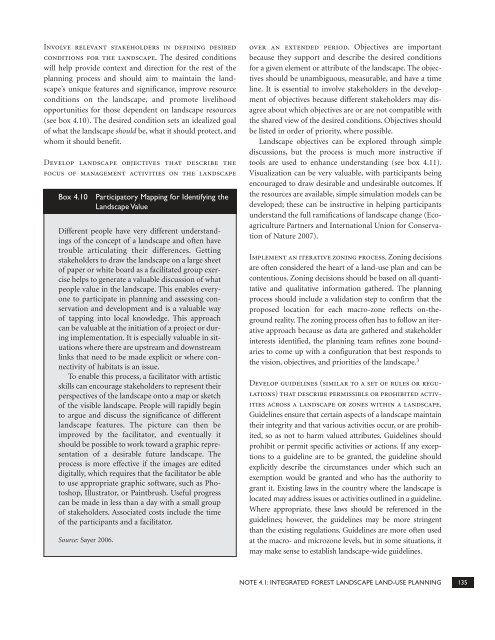Forests Sourcebook - HCV Resource Network
Forests Sourcebook - HCV Resource Network
Forests Sourcebook - HCV Resource Network
Create successful ePaper yourself
Turn your PDF publications into a flip-book with our unique Google optimized e-Paper software.
Involve relevant stakeholders in defining desired<br />
conditions for the landscape. The desired conditions<br />
will help provide context and direction for the rest of the<br />
planning process and should aim to maintain the landscape’s<br />
unique features and significance, improve resource<br />
conditions on the landscape, and promote livelihood<br />
opportunities for those dependent on landscape resources<br />
(see box 4.10). The desired condition sets an idealized goal<br />
of what the landscape should be, what it should protect, and<br />
whom it should benefit.<br />
Develop landscape objectives that describe the<br />
focus of management activities on the landscape<br />
Box 4.10<br />
Different people have very different understandings<br />
of the concept of a landscape and often have<br />
trouble articulating their differences. Getting<br />
stakeholders to draw the landscape on a large sheet<br />
of paper or white board as a facilitated group exercise<br />
helps to generate a valuable discussion of what<br />
people value in the landscape. This enables everyone<br />
to participate in planning and assessing conservation<br />
and development and is a valuable way<br />
of tapping into local knowledge. This approach<br />
can be valuable at the initiation of a project or during<br />
implementation. It is especially valuable in situations<br />
where there are upstream and downstream<br />
links that need to be made explicit or where connectivity<br />
of habitats is an issue.<br />
To enable this process, a facilitator with artistic<br />
skills can encourage stakeholders to represent their<br />
perspectives of the landscape onto a map or sketch<br />
of the visible landscape. People will rapidly begin<br />
to argue and discuss the significance of different<br />
landscape features. The picture can then be<br />
improved by the facilitator, and eventually it<br />
should be possible to work toward a graphic representation<br />
of a desirable future landscape. The<br />
process is more effective if the images are edited<br />
digitally, which requires that the facilitator be able<br />
to use appropriate graphic software, such as Photoshop,<br />
Illustrator, or Paintbrush. Useful progress<br />
can be made in less than a day with a small group<br />
of stakeholders. Associated costs include the time<br />
of the participants and a facilitator.<br />
Source: Sayer 2006.<br />
Participatory Mapping for Identifying the<br />
Landscape Value<br />
over an extended period. Objectives are important<br />
because they support and describe the desired conditions<br />
for a given element or attribute of the landscape. The objectives<br />
should be unambiguous, measurable, and have a time<br />
line. It is essential to involve stakeholders in the development<br />
of objectives because different stakeholders may disagree<br />
about which objectives are or are not compatible with<br />
the shared view of the desired conditions. Objectives should<br />
be listed in order of priority, where possible.<br />
Landscape objectives can be explored through simple<br />
discussions, but the process is much more instructive if<br />
tools are used to enhance understanding (see box 4.11).<br />
Visualization can be very valuable, with participants being<br />
encouraged to draw desirable and undesirable outcomes. If<br />
the resources are available, simple simulation models can be<br />
developed; these can be instructive in helping participants<br />
understand the full ramifications of landscape change (Ecoagriculture<br />
Partners and International Union for Conservation<br />
of Nature 2007).<br />
Implement an iterative zoning process. Zoning decisions<br />
are often considered the heart of a land-use plan and can be<br />
contentious. Zoning decisions should be based on all quantitative<br />
and qualitative information gathered. The planning<br />
process should include a validation step to confirm that the<br />
proposed location for each macro-zone reflects on-theground<br />
reality. The zoning process often has to follow an iterative<br />
approach because as data are gathered and stakeholder<br />
interests identified, the planning team refines zone boundaries<br />
to come up with a configuration that best responds to<br />
the vision, objectives, and priorities of the landscape. 3<br />
Develop guidelines (similar to a set of rules or regulations)<br />
that describe permissible or prohibited activities<br />
across a landscape or zones within a landscape.<br />
Guidelines ensure that certain aspects of a landscape maintain<br />
their integrity and that various activities occur, or are prohibited,<br />
so as not to harm valued attributes. Guidelines should<br />
prohibit or permit specific activities or actions. If any exceptions<br />
to a guideline are to be granted, the guideline should<br />
explicitly describe the circumstances under which such an<br />
exemption would be granted and who has the authority to<br />
grant it. Existing laws in the country where the landscape is<br />
located may address issues or activities outlined in a guideline.<br />
Where appropriate, these laws should be referenced in the<br />
guidelines; however, the guidelines may be more stringent<br />
than the existing regulations. Guidelines are more often used<br />
at the macro- and microzone levels, but in some situations, it<br />
may make sense to establish landscape-wide guidelines.<br />
NOTE 4.1: INTEGRATED FOREST LANDSCAPE LAND-USE PLANNING 135

















